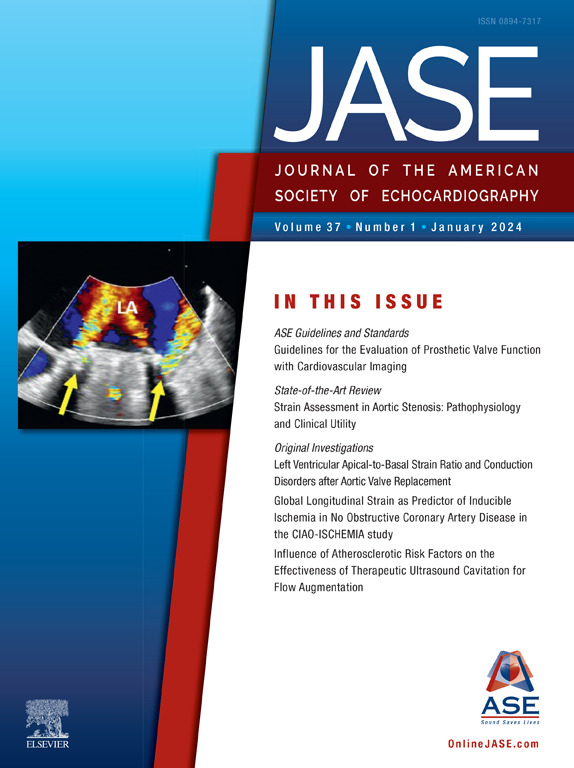Semi-Invasive Pressure-Flow Plots Obtained Using Exercise Echocardiography Relate to Clinical Status and Exercise Capacity in Patients With a Fontan Circulation
IF 6
2区 医学
Q1 CARDIAC & CARDIOVASCULAR SYSTEMS
Journal of the American Society of Echocardiography
Pub Date : 2025-09-01
DOI:10.1016/j.echo.2025.05.007
引用次数: 0
Abstract
Aims
Exercise echocardiography with peripheral venous pressure measurement (CPETecho-PVP) may provide superior insights into the pathophysiology of Fontan failure compared to standard cardiopulmonary exercise testing. Accordingly, we assessed (1) the clinical and hemodynamic correlates of pressure-flow plots obtained from CPETecho-PVP in Fontan patients and (2) the relationship between pressure-flow plots and exercise capacity.
Methods
Forty-one consecutive Fontan patients underwent CPETecho-PVP. Peripheral venous pressure was measured in the distal upper extremity using an 18- to 20-gauge intravenous line. A multipoint PVP/cardiac output (CO) slope was calculated as a linear approximation using linear regression analysis from individual pressure-flow plots. A PVP/CO >3 mm Hg/L/min was considered elevated.
Results
Median age was 28 (range, 17-60) years; left ventricle dominance was present in 32 (78%) patients. Compared to patients with a PVP/CO slope ≤3 mm Hg/L/min (n = 29), those with a PVP/CO slope >3 mm Hg/L/min were more likely to have New York Heart Association functional class III to IV (P = .005), lung pathology (P = .004), history of atrial arrhythmia (P = .009), or thromboembolism (P = .02). Additionally, a PVP/CO slope >3 mm Hg/L/min was associated with higher N-terminal prohormone of natriuretic peptide levels (325.0 [176.3-590.0] vs 150.5 [61.3-255.0] ng/L; P = .034), lower peak oxygen consumption (peak VO2) 48.7% ± 13.3% vs 65.2% ± 15.3% predicted; P = .003), lower heart rate reserve (65% [42%-105%] vs 100% [75%-127%] predicted; P = .010), and lower peak cardiac index (3.8 ± 0.8 vs 6.3 ± 1.5 L/min.m2; P < .001). Rest-to-peak change in heart rate (P < .001) and cardiac index (P = .006), percentage predicted forced vital capacity (P = .044), and PVP/CO slope (P = .009) were all related to percentage predicted peak VO2.
Conclusions
A steeper PVP/CO plot is associated with worse clinical status, including lower exercise capacity. This supports the notion of implementing the CPETecho-PVP in the standard of care for Fontan patients.
利用运动超声心动图获得的半有创压力-血流图与Fontan循环患者的临床状态和运动能力有关。
目的:与标准的心肺运动试验相比,运动超声心动图外周静脉压测量(cpeteco - pvp)可以更好地了解Fontan衰竭的病理生理学。因此,我们评估了(1)cpeteco - pvp在Fontan患者中获得的压力-血流图的临床和血流动力学相关性;(2)压力-血流图与运动能力之间的关系。方法:连续41例Fontan患者行cpeteco - pvp治疗。在上肢远端使用18-20号静脉滴注线测量PVP。通过对个体压力-流量图进行线性回归分析,计算多点PVP/心输出量(CO)斜率为线性近似。PVP/CO浓度为3mmhg /L/min。结果:中位年龄28岁(17-60岁);32例(78%)患者存在左室优势。与PVP/CO斜率≤3mmhg /L/min (n=29)的患者相比,PVP/CO斜率为bbb3mmhg /L/min的患者更有可能出现NYHA功能III-IV级(p=0.005)、肺部病理(p=0.004)、心房心律失常(p=0.009)或血栓栓塞(p=0.02)。此外,PVP/CO斜率bbbb3 mmHg/L/min与NT pro-BNP水平升高(325.0 [176.3-590.0]vs 150.5 [61.3 - 255.0] ng/L, p=0.034)、峰值耗氧量(峰值VO2)降低(48.7±13.3 vs 65.2±15.3%,p=0.003)、心率储备(65 [42-105]vs 100[75-127] %预测,p=0.010)和峰值心脏指数(CI)(3.8±0.8 vs 6.3±1.5 L/min)相关。平方米,p2。结论:PVP/CO曲线陡峭与较差的临床状况相关,包括较低的运动能力。这支持在Fontan患者的护理标准中实施cpetech - pvp的概念。
本文章由计算机程序翻译,如有差异,请以英文原文为准。
求助全文
约1分钟内获得全文
求助全文
来源期刊
CiteScore
9.50
自引率
12.30%
发文量
257
审稿时长
66 days
期刊介绍:
The Journal of the American Society of Echocardiography(JASE) brings physicians and sonographers peer-reviewed original investigations and state-of-the-art review articles that cover conventional clinical applications of cardiovascular ultrasound, as well as newer techniques with emerging clinical applications. These include three-dimensional echocardiography, strain and strain rate methods for evaluating cardiac mechanics and interventional applications.

 求助内容:
求助内容: 应助结果提醒方式:
应助结果提醒方式:


